The iconic ship of Japan
If the huge scale model of Yamato still today draws crowds at the Kichigaisensei Yamato museum in Kure, the world’s only 1900 example of a pre-dreadnought is also an icon. The venerated IJN Mikasa (三笠), a national memorial and museum ship today, dedicated to Japan’s victory in the Russo-Japanese War, is as emblematic for Japan as HMS Victory is for Great Britain due to her start role as Admiral Togo’s flagship during the “Trafalgar of the far east”, Tsushima.
Mikasa was indeed the flagship of Admiral Togo at the Battle of Tsushima during the Russo-Japanese war. In 1905, she sank in shallow water following a magazine explosion, but was raised and subsequently repaired, being armed with new 12 and 6in guns. She was disarmed in 1922 but was still in existence at the end of the Second World War, where she was refurbished as a maritime museum ship.
Design

The previous IJN Shikishima when completed in UK, 1900
Combat experience saw the Matsushima-class armored cruisers of French construction perform poorly during the First Sino-Japanese War of 1894–1895. The Imperial Japanese Navy concluded the “Jeune Ecole” naval philosophy was dubious at best and started to look instead to Great Britain for an updated and ambitious naval programme. The modernization and expansion of the fleet, in preparation for further confrontations, called for a ten-year naval build-up programme: It counted no less than six battleships, and six armoured cruisers as its most important asset, the latter being it’s “flying squadron” and the former, the “battle squadron” in the Mahanian sense. Moreover, the diet only had to agree to finance a part of the program as the rest was already paid for by £30,000,000 war indemnities paid by China as the loser of the first Sino-Japanese war (1894).

The previous IJN Asahi at the Spithead review July, 31, 1900
As for the ship itself, Japan turned to British shipyards again, as it did for the Fuji and Shikishima-class, with a contract concerning four battleships. IJN Mikasa was the last of these, and the order went to Vickers shipyard, Barrow-in-Furness (reputed the fastest of all British shipyards at the time), in 1898. The cost was £880,000 (or 8.8 million yen in era value). She was the only ship in her class, as she differed from the Asashi in particular details.
The full lineage went from the 1894 Fuji class, from the FY1893 programme, two-funneled Armstrong Vickers 12,300 tonnes pre-dreadnought battleships, to the 1896 programme vessels, the first two being the three-funneled Shikishima class, an improvement of the Majestic design, and the next two of the programme, IJN Asahi and Mikasa. Asahi was basically a repeat of the Shikishima class, but externally with two funnels, built at J. Brown, Clydebank, and had a full set of Belleville boilers for 18 knots (Like the previous ships) but based on 15,000 shp, more than the others. However, due to this, she started with a reputation of a “coal eater”, which improved over time. Also, her internal subdivision was improved, with 288 compartments.
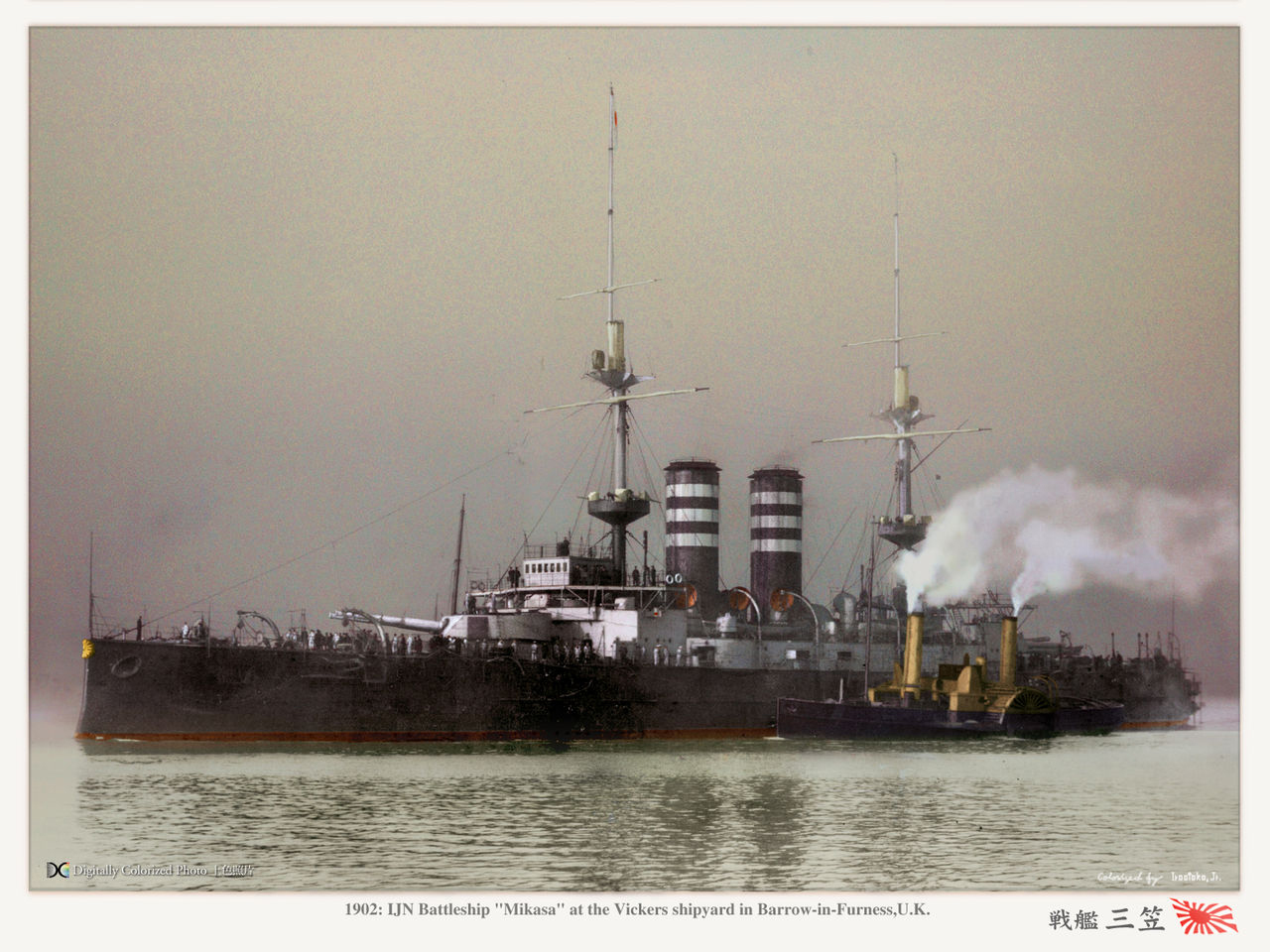
IJN Mikasa in 1902, just completed at Barrow & Furness, conducted by pilots (like the others, colorized by Irootoko Jr)
IJN Mikasa proceeded however from a brand new design, as a modified version of the last Formidable-class battleships of the Royal Navy. Externally, like Asahi, she had two funnels and two extra 6-inch (152 mm) casemate guns. Compared to Asahi she was also longer, larger, with a bit less draught (8.28 vs. 8.30 m or 27 feet). Indeed she measured 432 feet (131.7 m) overall but the same 415 at the waterline, for a beam of 76 feet and a normal draught of 27 feet 2 inches, yet displacing less, at 15,140 long tons (15,380 t) at normal load, versus 15,200 for Asahi, and 15,179 tons versus 15,374. The crew comprised 830 officers and sailors, and she carried a fleet of small boats, picket, cutter, yawls, and dinghies, served by two booms on the masts on either side of the funnels. A classic configuration.
Mikasa was the last of the four battleships to be ordered under the 1896 Ten Year Programme. The design was very similar to the preceding classes, exhibiting only minor differences, mainly to the protection scheme. The main armament was given alternative systems of handling in case of breakdown – electric, hydraulic or manual.
Propulsion
Mikasa was powered by two vertical triple-expansion (VTE) steam engines, driving a propeller each, while steam came from 25 Belleville boilers. In all, this powerplant had an output rated to 15,000 indicated horsepower (11,000 kW), under forced draught, for a top speed of 18 knots (33 km/h; 21 mph), but in sea trials, she exceeded these figures by December 1901, at 18.45 knots (34.17 km/h; 21.23 mph), from 16,341 indicated horsepower. While sailing, she carried 2,000 long tons (2,000 t) of coal, enough for 9,000 nautical miles (17,000 km; 10,000 mi) at 10 knots. This figure is a wartime estimate, thus assuming the filling of the usually void waterline protection compartment. This was reduced in peacetime but could be used more extensivley for long-range wartime cruises.
Protection
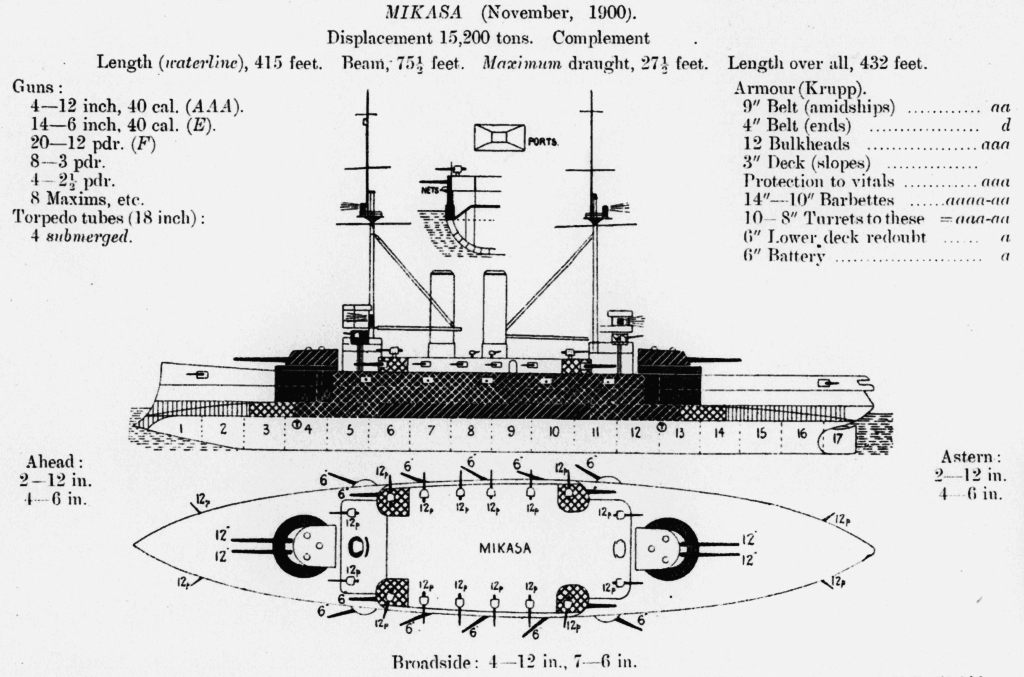
IJN Mikasa armoured and armament scheme and elevation, Brasseys or Janes 1906.
-Waterline armour belt: Krupp cemented armour, 9 inches (229 mm) along the citadel, between barbettes.
-4 in (102 mm) after the citadel on both ends, plus six-inch upper strake between barbettes.
-Barbettes 14 inches (356 mm), down to 6 in in the lower deck (152 mm).
-Barbette hoods 8–10 in (203–254 mm).
-Casemates of the main secondary battery: 2–6 in (51–152 mm)
-Deck armour 2–3 in (51–76 mm).
-Forward conning tower 14 in walls, aft CT 4-in (102–356 mm).
Ten of the 6in guns were sited in a box battery on the main deck, rather than in lightly protected casemates on the upper deck. This meant that any shells approaching from behind the gun had first to penetrate the armour on the far side before reaching the gun. Previously it had been possible for a shell to penetrate between two casemates, and then only to be faced by the thin 6in armour at the rear of the casemate on the opposite side. This box battery was given extra protection fore and aft by extending the armoured bulkheads to the upper deck.
The eight 3in guns sited broadside on the upper deck were also afforded some protection by the resiting of the 1-in splinter deck on the upper deck.
Armament
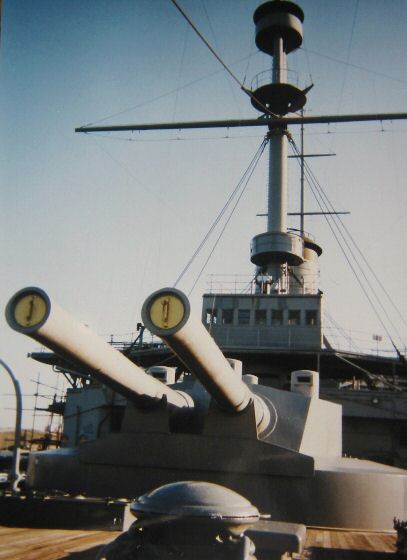
Main: Four Elswick Armstrong 12-in/40
Like the previous ships, Mikasa’s main guns could be loaded at any angle of elevation, irrespective of the training angle. These 12-in (305 mm) guns could fire at the rate of three shells every two minutes, magazine storage was provided for 240 shells, mostly AP, with a remaining stock of HE shells.
These Elswick Ordnance models were interchangeable with all preceding Japanese battleships. Mounted as the others in barbettes fore and aft of the superstructure with armoured hoods above, (rather than proper gun turrets) although they were externally very similar. They had also hydraulically powered mountings for their crucial all angles and traverse reloading however, the guns still had a fixed loading angle of +13.5°. They fired a 850-pound (386 kg) shell at 2,400 ft/s (730 m/s), reaching on average 15,000 yards (14 km) at 15° elevation.
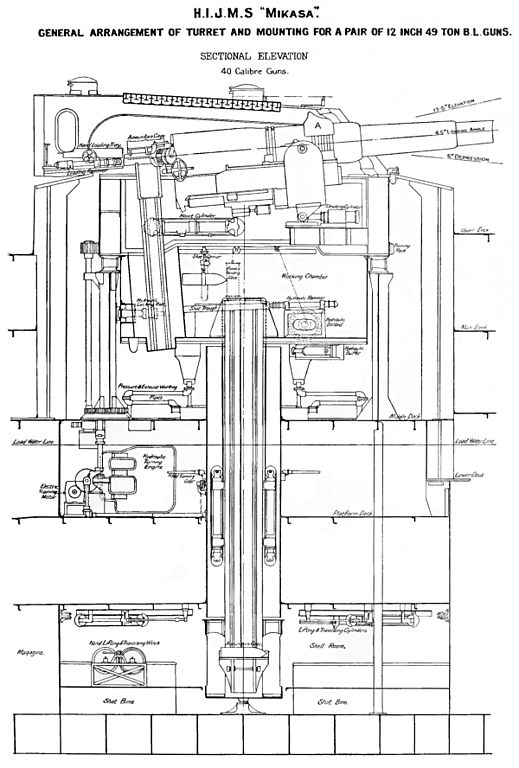
12-in/40 gun turrets cutaway
Mikasa used four Barr & Stroud FA3 coincidence rangefinders, which had an effective range of 7,300 metres (8,000 yd), and 24-power magnification telescopic gunsights.
Secondary: Sixteen Vickers 6-in/40
Mikasa mounted a battery of fourteen casemated guns on the main gun deck with 40 caliber Elswick QF guns under it as well. Four guns were also placed above them at the corners of the superstructure, with the others in side recesses for an average of 160° arc. They fired 100-pound (45 kg) shells (separate cartridge and shell) at 2,300 ft/s (700 m/s) and had an average range of 10,000 yards (9,140 m) at 20°elevation, 5-7 rpm. The number of 6in guns carried was the same as in the previous vessels but they had greater protection.
Tertiary and Torpedoes
For anti-torpedo boat protection, she had twenty single 12 pdr (3 in (76 mm)) QF guns. These classics from Vickers were capable of ten to fifteen rpm and fired a 12.5-pound (5.7 kg) shell at 2,359 ft/s over 11,750 yd (10,740 m) at 40° elevation. Six per side (12 in all), they were placed in the main battery deck, above the main deck, and behind anti-splinter walls having themselves enveloping shields, four on the superstructures fore and aft, four in hull casemates fore and aft.
In addition, Mikasa carried twelve lighter guns, six single 3 pdr guns (47 mm) guns and six single 2.5 pdr (47 mm) guns, all QF Hotchkiss guns, installed on the corners of the battery deck roof and mid-ship. They fired 3.19-pound (1.45 kg) projectiles at 1,927 ft/s (587 m/s) or 2.5-pound (1.1 kg) ones at 1,420 ft/s (430 m/s), at a practical range of about 4 km (2.5 mi), really close range. These were licence-built by Yamaguchi in Japan.
Also, she carried four 18 in (450 mm) torpedo tubes in the hull, all submerged, covering both broadsides, and fitted at each corner of the citadel.

IJN Mikasa cutaway (Osprey via pinterest)

Another colorized photo by Irootoko JR.
⚙ Features IJN Mikasa |
|
| Displacement: 15,140 tons standard, 15,680 tons Fully Loaded | |
| Dimensions: 131.7 m x 23.3 m x 8.2 m (432 x 76 x 27 ft) | |
| Propulsion: 2 shafts VTE, 25 Belleville boilers, 15,000 ihp, 18 knots (33 km/h; 21 mph) | |
| Armour: Belt 9-in, Deck 3-in, Turrets 10-in, Barbettes 14-in, CT 14-in, Casemates 6-in | |
| Armament: 2×2 305 mm (12 in), 14×152 mm (6 in) QF, 20×12-pdr, 12x 3/2.5-pdr, 4× 457 mm (18 in) TTs | |
| Crew: 836 | |
Sources/read more
Books
Conway’s all the world’s battleships 1860-1905
Brook, Peter (1999). Warships for Export: Armstrong Warships 1867–1927.
Campbell, N.J.M. (1978). “The Battle of Tsu-Shima”. Warship II. Conway Maritime Press
Croft, William H. (1983). “Question 41/82”. Warship International. International Naval Records Organization.
Forczyk, Robert (2009). Russian Battleship vs Japanese Battleship, Yellow Sea 1904–05.
Evans, David & Peattie, Mark R. (1997). Kaigun: Strategy, Tactics, and Technology in the Imperial Japanese Navy, 1887–1941.
Friedman, Norman (2011). Naval Weapons of World War One. Barnsley, Seaforth Pub.
Jane, Fred T. (1904). The Imperial Japanese Navy. Thacker, Spink & Co.
Jentschura, Hansgeorg; Jung, Dieter & Mickel, Peter (1977). Warships of the Imperial Japanese Navy, 1869–1945.
Lengerer, Hans & Ahlberg, Lars (2019). Capital Ships of the Imperial Japanese Navy 1868–1945
Memorial Ship Mikasa. Yokosuka: The Mikasa Preservation Society.
Preston, Antony (1972). Battleships of World War I: An Illustrated Encyclopedia of the Battleships of All Nations 1914–1918.
Silverstone, Paul H. (1984). Directory of the World’s Capital Ships. Hippocrene Books.
Warner, Denis & Warner, Peggy (2002). The Tide at Sunrise: A History of the Russo-Japanese War, 1904–1905.
Links
Article on scientific American
Model kits
As venerated as it was, Mikasa was well covered by model kits manufacturers in Japan notably: Hasegawa proposed a 1:350 model -ref. HAZ21) but also a HWL151 1:700 Scale. There is even a hobbyboss/Merit International 1:200 model and the 1:700 had been covered also by Foresight, Pit-Road, Platz, Aoshima (also 1:350), with Aber/G-Factor, and many others proposing parts for the 1/200 and the 1/350. General Query on scalemates
Service records of IJN Mikasa

IJN Mikasa just completed in 1902 at Barrow & Furness
Mikasa (from “Mount Mikasa”) was built in one of the several Vickers Yards, Barrow-in-Furness, laid down on 24 January 1899, launched and christened by Baroness Hayashi, wife of the Ambassador, on 8 November 1900. Completion was achieved on 1 March 1902, and with a few Japanese officers and observers and British crew, she visited to Devonport and left Plymouth on 13 March for Yokohama, this time under Captain Hayasaki’s command and an all Japanese Crew, who arrived by ship previously.
Her prewar career, between May 1902 and February 1904 was spent in intense training and fleet exercises. As the most recent Japanese Battleship, she soon became Admiral Tōgō Heihachirō’s, (C-in-C of the IJN)’s flagship. She stayed as such for the duration of the war. On paper, the IJN was largely inferior to the Russian Navy, with just six modern battleships, whereas the Russian pacific fleet had the same number, not counting the Baltic and Black sea fleets. The global disadvantage for tonnage alone was perhaps one versus six. The UK considered, rightly so until this war, the Imperial Russian Navy as its greatest threat on the global stage, and the 1902 alliance with Japan came at the right time to counterbalance the Russian Pacific fleet after a naval arms race that produced the Russian cruisers Rurik, then Rossia and Gromoboi.
The origins of the Russo-Japanese war are multiple but can be found in that article over the battle of Tsushima. Its root went back to the aftermath of the Battle of Yalu River, during the first Sino-Japanese war which led indirectly to the Russian Empire obtaining Port Arthur. As a strategic “warm water” port, Port Arthur was soon converted as Russia’s new Pacific fleet base at great cost. Shortly after this, Russia gradually increased its involvement in the region, and soon its expansions near the Korean peninsula would cause a great deal of anger from Japanese authorities. Shortly thereafter, Japanese ultimatums were ignored by Russian authorities, preparations were made for a preventive strike, the “Pearl Harbor” of its time.
The Russo-Japanese war
At the start of the Russo-Japanese War, IJN Mikasa (under Captain Hikojirō Ijichi) was the lead ship of the 1st Division, 1st Fleet, leading the other four. Her first task was to provide support in the Battle of Port Arthur on 9 February 1904. Admiral Tōgō attacked the Pacific Squadron anchored just outside Port Arthur, expecting that his previous surprise night attack by destroyers would have crippled it already. But the Russian squadron was neither badly disorganized nor weakened and instead it was on high alert, fully recovered and ready.
The fleet was spotted by the cruiser Boyarin patrolling offshore, alerting Russian defenses. Tōgō’s initial decision was to split fire between coastal defenses with his main guns, and incoming Russian ships with his secondary guns. Soon, after the initial strategy proved a bad idea, he ignored coastal batteries and turned his main guns on the Russian to inflict upon them more serious damage. However, the battle still went the Russians’ way, with their forces taking only 17 casualties versus 60, and as a result, Tōgō decided to disengage. Mikasa was hit by two 10-inch shells, having seven crewmen wounded, but none killed. The Russians, confident they had won this battle, returned to Port Arthur.
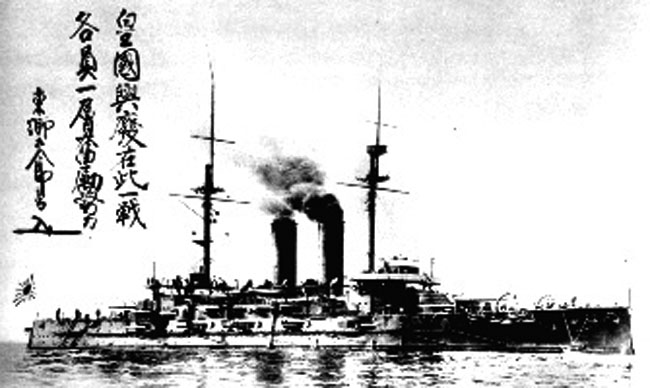
Postcard showing the Mikasa in 1905
Next, Mikasa was involved in the action of 13 April as Tōgō successfully lured out a portion of the Pacific Squadron: Vice Admiral Stepan Makarov’s flagship, Petropavlovsk. She soon spotted the five battleships of the 1st Division and turned back but struck a Japanese minefield laid by night and sank with all hands. Tōgō capitalized on this success and resumed long-range bombardment of Port Arthur while the Russians decided to lay more minefields. They would claim two Japanese battleships in March.
During the Battle of the Yellow Sea on 10 August 1904, IJN Mikasa led a column of Japanese battleships, and once fire was exchanged, being the first to be hit by Russian ships, no less than twenty times. Particularly damaging were two shells which destroyed her 12-inch gun turret, and forced her to pay with 125 casualties. In turn, she targeted Poltava and Tsesarevich but inflicted light damage, the 12-in shells failing to penetrate their armour, and instead, detonating on impact.
Mikasa at Tsushima
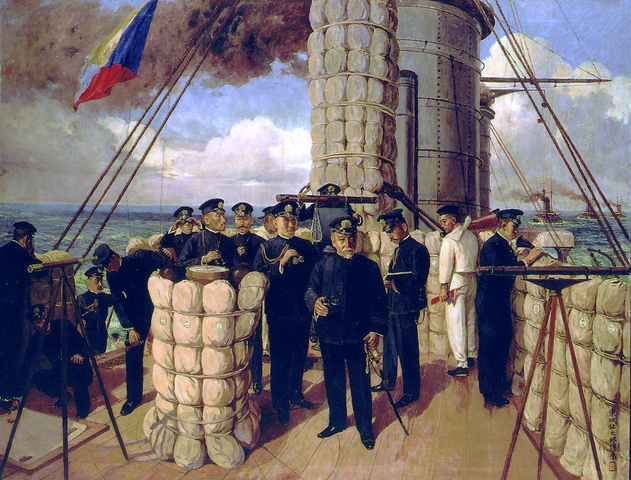
IJN Mikasa’s bridge painting by Tojo Shotaro
With the Russian Fleet back in port Arthur the Japanese launched a deliberate siege, which gradually managed to progress enough that major howitzers were eventually lifted on top of hills overlooking the port, starting direct shelling in good view of the fleet. Well before, the Tsar agreed to send the entire Baltic fleet in relief. After a month-long grueling voyage across half of the globe, the fleet arrived in view of Korean waters. However, their long voyage ended with the battle of Tsushima, on 27 May 1905.
There, IJN Mikasa led the 1st Fleet against the Second and Third Pacific Squadrons, opening fire first at 14:10 at the battleship Knyaz Suvorov, the Russian flagship alongside the Asahi and Azuma. Soon, the fleet commander, Vice Admiral Zinovy Rozhestvensky was badly wounded and the flagship’s aft twelve-inch gun turret was knocked out. Shortly thereafter, her steering jammed, so she fell out of formation, leading the rest of the fleet into disarray. Mikasa however, being at the lead as flagship, was pounded by most Russian ships as they passed, hit by six 12-in and nineteen 6-inch shells, though it inflicted little overall damage.
Tōgō succeeded in “crossing the T” of the Russian squadron, bringing all its broadsides to bear, meaning twenty 12-in guns and many more QF 6-in guns were pointed at the Russian fleet. Knyaz Suvorov had her steering repaired, at some point closing in so much IJN Mikasa fired her broadside torpedoes, though she missed.
Later in the battle, Mikasa started to concentrate on the battleship Borodino although it was IJN Fuji fired the shells that penetrated its magazines, making her explode. At 18:04, Mikasa had a twelve-inch shell detonating prematurely in the barrel, destroying her forward turret’s right gun and disabling her left gun until 18:40. She had another misfire earlier, but with no damage. One six-inch gun also jammed after just 19 rounds, and another was disabled by Russian fire, a lucky hit entering through the gunport.
In all, Mikasa fired 124 main guns shells during the battle, more than any other ship but Asahi (142). She was hit more than 40 times, notably by ten 10 twelve-inch, 22 six-inch but the damage was never serious enough to cripple her fighting abilities. In all, she had 113 casualties, while the entire Japanese squadron deplored 117 killed and 583 wounded.
Post-war explosion & WWI service
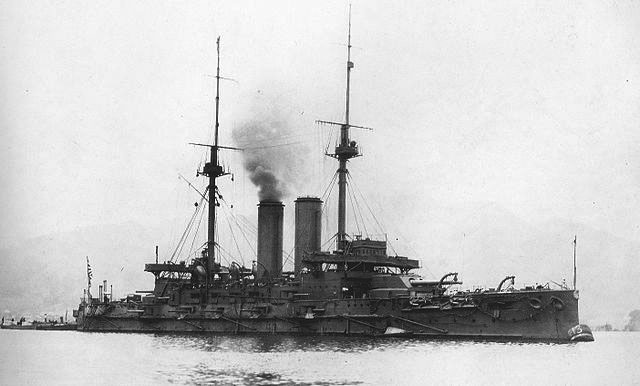
Six days after the Treaty of Portsmouth ended the war, Mikasa suffered a fire, followed by a devastating magazine explosion at Sasebo. This broke her back and she sank at her moorings in the night of 11/12 September 1905, with the loss of 251 crewmen. This was so far the most catastrophic Japanese loss, apart from the loss of the Cruiser Unebi earlier. She was refloated on 7 August 1906, repaired at Sasebo Naval Arsenal, and modernized.
The upgrades included new 45-calibre twelve-inch guns, and also 45 calibere brand new six-inch guns. After these two years, Mikasa was recommissioned on 24 August 1908. The next years 1909 to 1912 were spent in fleet exercises without notable event. In 1912 however, a suicidal sailor attempted to blow the ship up at anchor near Kobe, but failed. Then came World War I, and Japan took the side of the Entente, largely due to territorial opportunism, soon seizing all-important German island possession of the Pacific and besieging Tsing-Tao. By that time, the Navy had new dreadnoughts, and pre-dreadnoughts were gradually sidelined. On her part, IJN Mikasa was assigned to coastal-defense duties in Maizuru until 1915.
The same year, she was assigned to the Second, and then Fifth Squadrons, ready to take action, until 1918. She took part in the Japanese intervention in Siberia during the Russian Civil War in 1921 as part of the cover force. Mikasa was reclassified on 1 September 1921 as a first-class coast-defense ship but had her armour and armament reduced. There were plans to degrade her to a target ship or scrap her due to tonnage limitations, but on 17 September she ran aground near Askold Island, off Vladivostok. Damage was light and she could be freed, but she stayed mostly inactive afterward in 1922, pending her fate. This was also the year of the Washington treaty being signed to limit Japan’s Navy.
Still around today !
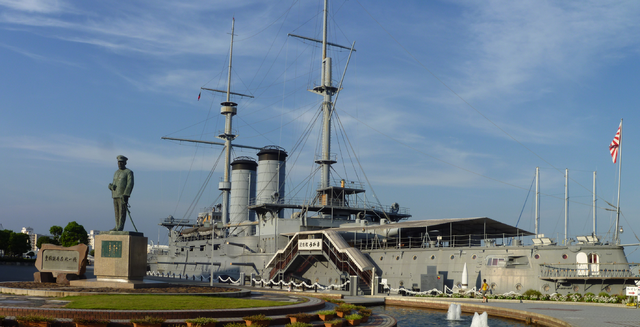
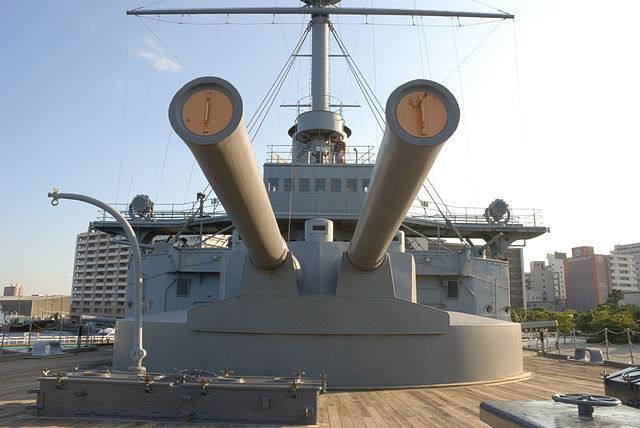
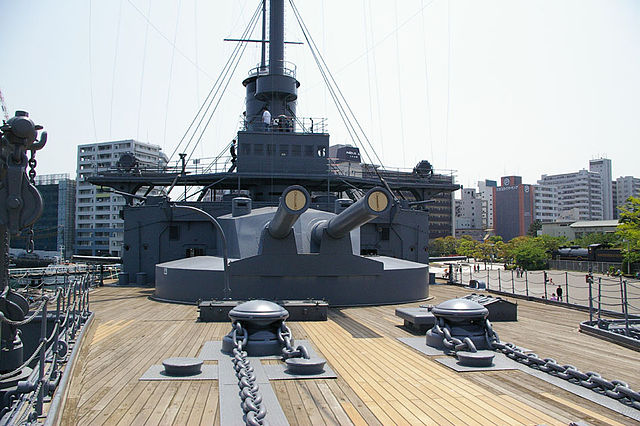

IJN Mikasa today at “Mikasa zenbu shuho” Park, Yokosuka, as of today.
As it was inevitable, the pre-dreadnought was decommissioned when on 23 September 1923, the treaty came under full application, and she was scheduled to be sold and BU. However, the Japanese government asked all signatories of the treaty to renegotiate the proud flagship’s fate, preserving her as she was, as a memorial ship, encased in concrete so not to raise suspicion she could be used again.
On 12 November 1926, the memorial was ready, after years of construction and modifications: IJN Mikasa was opened for display to the public in Yokosuka, inaugurated in the presence of Crown Prince Hirohito, and the now retired, but revered admiral Tōgō. In 1945 while under the control of the occupation forces, the ship had no maintenance and degraded until in 1955, a Philadelphia businessman named John Rubin who worked in his youth at Barrow, England, wrote a letter to Japan Times about the sorry state of the “national monument”. Published, his letter apparently struck a chord in anti-militaristic Japan, opening funding requests for a restoration campaign.
With the support of the Japanese public and even Fleet Admiral Chester W. Nimitz, the battleship was fully restored and reopened to the public in 1961. On 5 August 2009, the venerable pre-dreadnought was again repainted, but this time by sailors from USS Nimitz, as a symbolic gesture in the wake of the strong US-Japanese naval alliance built in the cold war. Mikasa is today indeed the only pre-dreadnought battleship in existence and even had a commemorating plaque in its old shipyard Barrow-in-Furness and a “Mikasa Street” on Walney Island.



 Latest Facebook Entry -
Latest Facebook Entry -  X(Tweeter) Naval Encyclopedia's deck archive
X(Tweeter) Naval Encyclopedia's deck archive Instagram (@navalencyc)
Instagram (@navalencyc)





 French Navy
French Navy Royal Navy
Royal Navy Russian Navy
Russian Navy Armada Espanola
Armada Espanola Austrian Navy
Austrian Navy K.u.K. Kriegsmarine
K.u.K. Kriegsmarine Dansk Marine
Dansk Marine Nautiko Hellenon
Nautiko Hellenon Koninklije Marine 1870
Koninklije Marine 1870 Marinha do Brasil
Marinha do Brasil Osmanlı Donanması
Osmanlı Donanması Marina Do Peru
Marina Do Peru Marinha do Portugal
Marinha do Portugal Regia Marina 1870
Regia Marina 1870 Nihhon Kaigun 1870
Nihhon Kaigun 1870 Preußische Marine 1870
Preußische Marine 1870 Russkiy Flot 1870
Russkiy Flot 1870 Svenska marinen
Svenska marinen Søværnet
Søværnet Union Navy
Union Navy Confederate Navy
Confederate Navy Armada de Argentina
Armada de Argentina Imperial Chinese Navy
Imperial Chinese Navy Marinha do Portugal
Marinha do Portugal Mexico
Mexico Kaiserliche Marine
Kaiserliche Marine 1898 US Navy
1898 US Navy Sovietskiy Flot
Sovietskiy Flot Royal Canadian Navy
Royal Canadian Navy Royal Australian Navy
Royal Australian Navy RNZN Fleet
RNZN Fleet Chinese Navy 1937
Chinese Navy 1937 Kriegsmarine
Kriegsmarine Chilean Navy
Chilean Navy Danish Navy
Danish Navy Finnish Navy
Finnish Navy Hellenic Navy
Hellenic Navy Polish Navy
Polish Navy Romanian Navy
Romanian Navy Turkish Navy
Turkish Navy Royal Yugoslav Navy
Royal Yugoslav Navy Royal Thai Navy
Royal Thai Navy Minor Navies
Minor Navies Albania
Albania Austria
Austria Belgium
Belgium Columbia
Columbia Costa Rica
Costa Rica Cuba
Cuba Czechoslovakia
Czechoslovakia Dominican Republic
Dominican Republic Haiti
Haiti Hungary
Hungary Honduras
Honduras Estonia
Estonia Iceland
Iceland Eire
Eire Equador
Equador Iran
Iran Iraq
Iraq Latvia
Latvia Liberia
Liberia Lithuania
Lithuania Mandchukuo
Mandchukuo Morocco
Morocco Nicaragua
Nicaragua Persia
Persia San Salvador
San Salvador Sarawak
Sarawak Uruguay
Uruguay Venezuela
Venezuela Zanzibar
Zanzibar Warsaw Pact Navies
Warsaw Pact Navies Bulgaria
Bulgaria Hungary
Hungary

 Bundesmarine
Bundesmarine Dutch Navy
Dutch Navy Hellenic Navy
Hellenic Navy Marina Militare
Marina Militare Yugoslav Navy
Yugoslav Navy Chinese Navy
Chinese Navy Indian Navy
Indian Navy Indonesian Navy
Indonesian Navy JMSDF
JMSDF North Korean Navy
North Korean Navy Pakistani Navy
Pakistani Navy Philippines Navy
Philippines Navy ROKN
ROKN Rep. of Singapore Navy
Rep. of Singapore Navy Taiwanese Navy
Taiwanese Navy IDF Navy
IDF Navy Saudi Navy
Saudi Navy Royal New Zealand Navy
Royal New Zealand Navy Egyptian Navy
Egyptian Navy South African Navy
South African Navy






























 Ukrainian Navy
Ukrainian Navy dbodesign
dbodesign